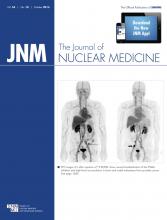REPLY: We read with interest the comments by Yakushev et al. regarding our article (1) examining the dependence of competition on the timing and magnitude of endogenous striatal and extrastriatal dopamine release using a single 18F-fallypride PET recording and the linearized simplified reference region model (LSSRM) (2).
As they point out correctly, marked changes in regional cerebral blood flow (rCBF) can be a potential confounding factor in detecting neurotransmitter release (3). It could thus be hypothesized that the results reported in the in vivo reward task study as part of the article (1) may simply be due to a change in 18F-fallypride delivery or tissue efflux and not to competing dopamine release induced by a reward task.
We argue that in this single-injection protocol with the combination of the in vivo kinetics of 18F-fallypride and the LSSRM approach, it is unlikely that rCBF-related changes would add major perturbations in ligand displacement, also under task paradigm conditions, as was also already stipulated by other simulation studies (2,4).
Although the LSSRM has several advantages by virtue of its requiring only single-day scanning and a single synthesis and administration of the radiochemical, and consequently avoiding session effects, practical implementation of the model implies that possible time-dependent alterations in rCBF are not fully accounted for. Briefly, as described in Equation 2 in the supplemental material of our article (1), the LSSRM can account for changes in perfusion via the β-parameter. Implementation of the full model is best suited for estimation of 4 parameters at a time. Attempts to estimate more than 4 parameters would result in a large covariance between the time-dependent parameters (α, β, and γ), translating into unreliable estimates. Therefore, parameters were customarily estimated by fixing α = β = 0 and estimating the other 4 parameters (R, k2, k2a, and γ). This has indeed the potential of biasing the γ-estimate (i.e., 18F-fallypride displacement).
Previous simulation studies have investigated the effects of transient increased ligand displacement and increased rCBF—considering possibilities such as proportional increase in transport (K1) and clearance rate (k2) so that the distribution volume remained constant—and separate increases in K1 and k2 (4). In the case of simultaneous increases, the changes in the PET binding curves are negligible. Increasing K1 results in an increased tracer uptake with negative γ-estimates. On the other hand, an increase of 10% in k2 results in significant positive γ-parameters. Therefore, the only possible confounding circumstance causing a positive measurement of γ due to blood flow alterations is an exclusive increase in k2. If the permeability/surface product is assumed constant, a 10% increase in K1 corresponds to a blood flow increase of approximately 30% for a typical flow rate of 0.5 mL/(g⋅min) (5). Assuming that the nondisplaceable binding is unaffected by the activation condition, a 10% increase in k2 would also correspond to a 30% blood flow increase. This magnitude of blood flow increase, however, is not within the expected range during performance of a reward task. Activation perfusion studies with 15O-H2O and functional MRI have shown that the increase in orbitofrontal rCBF during performance of a monetary reward task is on the order of few percentage points (6–8). Nevertheless, simulations of the activation state have demonstrated that the LSSRM fits the data well even when rCBF-related effects were on the order of 20% (2). This rCBF-related issue was also addressed by Slifstein et al. (5), suggesting that artifactual rCBF-induced changes in measured radioligand binding are minor for 18F-fallypride.
In addition, the recent findings of Cumming et al. (9) gave preliminary evidence that individual differences in global perfusion (using an image-derived surrogate of mean global cerebral blood flow) may bias the estimation of 18F-fallypride nondisplaceable binding potential in the striatum but not in low-binding regions (i.e., thalamus and the inferior temporal lobe). Therefore, although rCBF may be a factor influencing the estimation of 18F-fallypride nondisplaceable binding potential in regions with high receptor concentrations (i.e., striatal regions), this influence should be less important in low-binding regions (i.e., extrastriatal regions), where changes were observed in the monetary reward task study.
We therefore are confident that our observations with 18F-fallypride and LSSRM are not artifacts of non–receptor-related effects such as altered cerebral perfusion and that the increased radioligand washout k2a in response to reward-induced stimulation actually reflects reduced nondisplaceable binding potential detecting the presence of endogenous dopamine neurotransmission.
Footnotes
Published online Aug. 1, 2013.
- © 2013 by the Society of Nuclear Medicine and Molecular Imaging, Inc.







